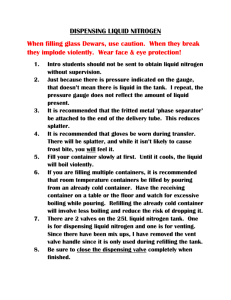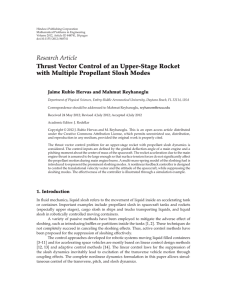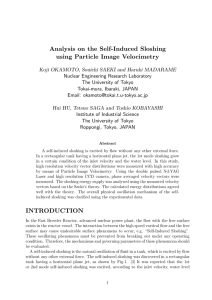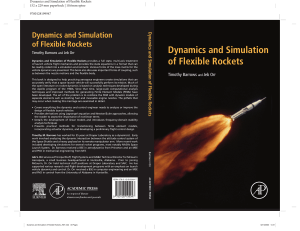Analytical Model of Liquid Slosh - Verification Experiment
advertisement
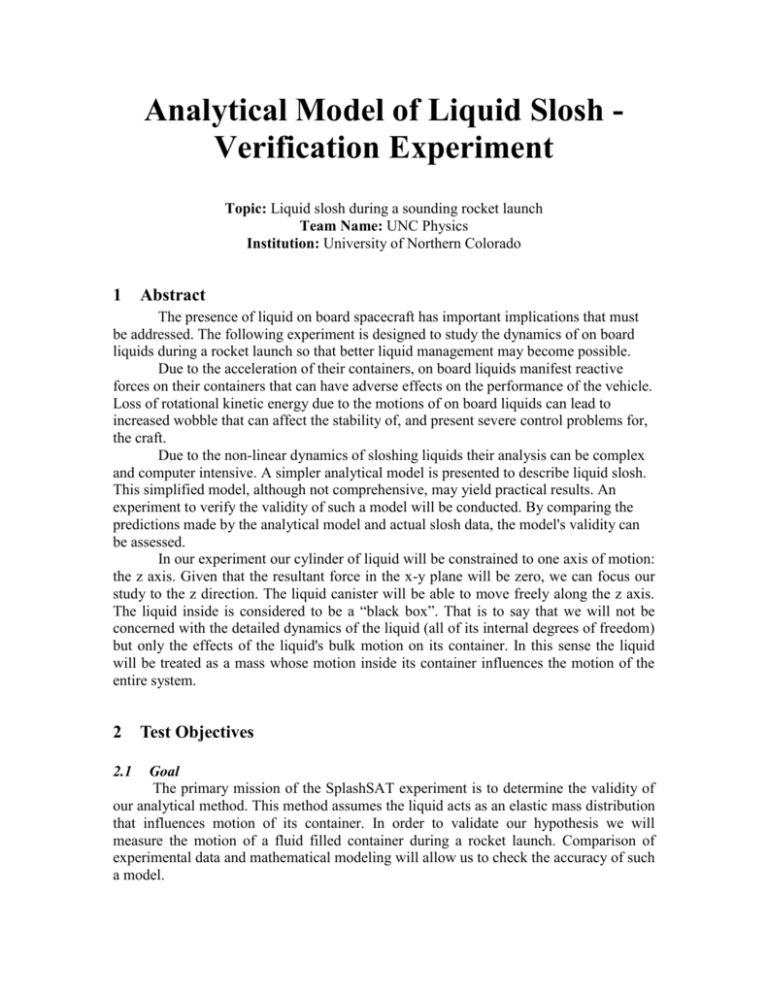
Analytical Model of Liquid Slosh Verification Experiment Topic: Liquid slosh during a sounding rocket launch Team Name: UNC Physics Institution: University of Northern Colorado 1 Abstract The presence of liquid on board spacecraft has important implications that must be addressed. The following experiment is designed to study the dynamics of on board liquids during a rocket launch so that better liquid management may become possible. Due to the acceleration of their containers, on board liquids manifest reactive forces on their containers that can have adverse effects on the performance of the vehicle. Loss of rotational kinetic energy due to the motions of on board liquids can lead to increased wobble that can affect the stability of, and present severe control problems for, the craft. Due to the non-linear dynamics of sloshing liquids their analysis can be complex and computer intensive. A simpler analytical model is presented to describe liquid slosh. This simplified model, although not comprehensive, may yield practical results. An experiment to verify the validity of such a model will be conducted. By comparing the predictions made by the analytical model and actual slosh data, the model's validity can be assessed. In our experiment our cylinder of liquid will be constrained to one axis of motion: the z axis. Given that the resultant force in the x-y plane will be zero, we can focus our study to the z direction. The liquid canister will be able to move freely along the z axis. The liquid inside is considered to be a “black box”. That is to say that we will not be concerned with the detailed dynamics of the liquid (all of its internal degrees of freedom) but only the effects of the liquid's bulk motion on its container. In this sense the liquid will be treated as a mass whose motion inside its container influences the motion of the entire system. 2 2.1 Test Objectives Goal The primary mission of the SplashSAT experiment is to determine the validity of our analytical method. This method assumes the liquid acts as an elastic mass distribution that influences motion of its container. In order to validate our hypothesis we will measure the motion of a fluid filled container during a rocket launch. Comparison of experimental data and mathematical modeling will allow us to check the accuracy of such a model. 2.2 Goal We hypothesize that our mathematical model will accurately describe the motion of the liquid filled container during a rocket flight. The SplashSAT experiment is designed to collect data throughout the duration of the flight. This data will be analyzed, and it will be determined how well the mathematical model developed predicts real flight data. 2.3 Uniqueness The experiment is unique in its relevance. Current unmanned and future manned missions will require a careful understanding of liquid slosh and its dynamics. Both the experiment and the mathematical model were constructed and developed by students anticipating the importance of liquid dynamics to the aerospace field in the coming years. 3 Test Description 3.1 Mathematical Model Our mathematical model, which follows, can predict, among other things, the modes of oscillation which the undamped system can display. We begin with the following experimental apparatus (Figure 1.1). We then represent this situation as a pair of coupled damped harmonic oscillators where m1 represents the liquid's mass and m2 represents the mass of the tank. The motion of the liquid is communicated to the tank by k’, the constant describing the strength of the coupling spring. k’ Springs m1 k’ Liquid filled Tank m2 Springs k Figure 1.1 Figure 1.2 From the diagram the force equations are as follows: m x kx k ( x x ) m g x 1 1 1 2 1 1 1 m x k x k ( x x ) m g x 2 2 2 1 2 2 2 (1) As mentioned above, m1 and m2 are the masses of the liquid and container, respectively. k and k are the spring constants. k speaks to the container's connection to the craft and k' to the liquid's elasticity. Also note that and are damping coefficients. describes the damping affecting the liquid and quantifies the damping due to the coupling friction with the craft. Factoring out a k and k respectively results in the following: m g m x k ( x 1 ) k ( x x ) x 1 1 1 2 1 1 k m g 2 m x k ( x ) k ( x x ) x 2 2 2 1 2 2 k m m 1g 2g By substituting Ux1 and Vx2 we find: k k k g m U kU k ( V U ) ( m m ) U 1 2 1 k k g m V k V k ( U V ) ( m m ) V 2 1 2 k (2) (3) Next we assume the standard trial solution: U A 1 i t V A e 2 (4) This solution leads to the following in matrix notation: m A kA k ( A A ) A 1 k g 1 1 1 2 1 1 i ( m m ) 2 1 m A k A k ( A A ) A 1 k 2 2 2 1 2 2 (5) Next we find homogeneous equation: 2 A 0 1 m k k i k k g 1 1 ( m m ) 2 1 (6) 2 A 0 1 k m k k i 2 2 k Then, we can find the determinant of the matrix in order to form a constraint for the solutions. The following example is the constraint during a free fall situation where g 0 : ( m k k i )( m 2 k i ) k 0 2 1 2 2 2 (7) For the undamped case, this equation can be analytically solved for revealing the frequencies for normal mode oscillations. However, the damped situation cannot be solved analytically for . Still, a computer can solve the damped case by approximating roots of the characteristic equation above. The only unknown variable is . All other variables represent measurable physical quantities. Even and can be measured; from our trial solution we understand 1 1 that: t and t are time scales for damping. These critical values are the time over which an oscillation amplitude will decrease by a factor of 1/e. 3.2 Data Collection Velocity: IR sensors mounted at the base and top of the rail will record the motion of the container as its slides up and down along the rail (See Fig 7.1). Accelerometer: To record accelerations of the plane, we will use a series of accelerometers. 3.3 Data Analysis The data collected by the IR sensors will allow us to determine the position, velocity, and acceleration of the container along the rail. The frequency of the system's oscillation will be obtained from these results. These results will then be used in conjunction with the mathematical model to determine the models accuracy. 4 References El-Sayad, M., Hanna, S., and Ibrahim, R “Parametric Excitation of Nonlinear Elastic Systems involving Hydrodynamic Sloshing Impact,” Nonlinear Dynamics, Vol 18, 1999, pp 25-50. Vreeburg, J.P.B., “Diagnosis of water motion in the Sloshsat FLEVO tank”, National Aerospace Laboratory NLR, 2000. Walchko, K., “Robust Nonlinear Attitude Control with Disturbance Compensation”, Graduate Thesis, University of Florida, 2003. Anderson J., Turan, O., and Semercigil, S., “A Standing-wave type Sloshing Absorber to Control Transient Oscillations,” Journal of Sound Vibration, Vol 232, No 5, 2000, pp 839-856. Sidi, M., Spacecraft Dynamics and Controls, Cambridge University Press, New York, 1997. Hughes. P., Spacecraft Attitude Dynamics, John Wiley & Sons, New York 1986. 5 Experiment Safety Evaluation 5.1 Experiment Description and Background. The goal of the experiment is to determine the viability of our mathematical model. A tank filled with liquid (water) will be constrained by rails so that it may only move along one axis throughout the duration of the flight. The displacement along the rails as the liquid filled tank moves will be recorded. This data will be later used for analysis on the ground. We expect that the actual flight data will match the predictions of our mathematical model. 5.2 Electrical System The electrical system is very simple in this experiment. There is only a sensor board that is powered by a small 4.8v NiCd battery. This sensor board consists of an AVR micro controller, a 3-axis accelerometer and connections for the IRS's. Hazard Analysis Water Spills: The cylinder that holds the water will be constructed of Lexan, a very strong plastic. This container will be glued together with an epoxy designed to bond Lexan, and then will have a sealant applied over all joints. In case this system fails, there is an exterior waterproof cage in place. 5.3

